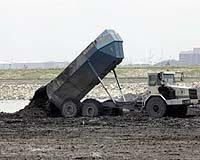Singapore might not ne known for being an eco-friendly. Its carbon footprint, with its giant a/c malls and permanent construction work, is quite heavy.
However Singapore is trying hard to counterbalance some of these negative effects – with an efficient subway system, more buses (when will they be green tough?), and a toll road to get into the City …whose price just doubled in January.
Singapore also got this interesting idea: Semakau island – a waste island transformed into a eco-tourism site >..
A nature haven has blossomed in an unlikely location barely a 20-minute ferry ride from the mainland of the land-scarce city-state, whose economic success and rapid modernisation generates a massive amount of waste daily.
The 350-hectare (865-acre) offshore landfill, comprising two natural islets connected by a rock embankment, can hold 63 million cubic metres (81.9 million cubic yards) of rubbish, enough to accommodate Singapore’s landfill needs until 2045.
Thanks to the work of scientists, planners, engineers and environmentalists, a rich variety of flora and fauna is surviving on the island, including 55 species of birds like the endangered great-billed heron.
Recent private surveys on Semakau’s relatively unexplored marine life have also yielded exciting discoveries including a vast meadow of rare tape seagrass, giant barramundi cod and even reported sightings of black-tipped sharks.
“Semakau’s marine life is amazingly rich… some parts of it are so rare that it can no longer be found elsewhere in Singapore,” Ria Tan, who owns a popular nature website, Wild Singapore, said.
Worries of animals feeding on the refuse are unfounded, as more than 80 percent of the waste consists of inorganic matter, and is unlikely to attract any preying animals, according to the landfill’s general manager, Ong Chong Peng.
“We had this concept to build a pretty unique landfill, yet at the same time ensure that the eco-system remains preserved and protected,” Ong told AFP during a visit to the island.
To ensure that the surrounding areas stay pollution-free, Ong and his team of 100 staff employ compactors and bulldozers to level the waste after it is dumped into landfill cells lined with a thick plastic membrane. The cells are then topped off with fertile soil.
Two mangrove plantations were also replanted next to the landfills, serving as biological indicators should there be any leaks of harmful waste into the sea, Ong said.
“The basic premise of our operations was creating an island from the sea, by dumping waste,” said the landfill’s operations manager, Loo Eng Por, who has been working on the island since it began operations in 1999.
The idea of having a tourist attraction made from garbage was recently mooted by Minister of Environment and Water Resources Yacoob Ibrahim, who sees Semakau as an example of how refuse and conservation can co-exist.
Mr Tan, who is also an associate member of one such group engaging in biodiversity research, organises hour-long nature tours of the island’s extensive seagrass clusters and wildlife-teeming mangroves. “We try to keep (the walks) short, sweet and pleasant… You’ll never know whether urbanites like Singaporeans will enjoy them or not, but I’m pretty sure nature lovers will,” she said confidently.
But Ho Hua Chew, an avid bird-watcher with another interest group permitted to travel to the island, sounded a word of caution. “The bigger the landfill, the lesser the indigenous animals and inter-tidal marine life… we mustn’t extend the idea that landfills are good for biodiversity,” Ho said between hopeful peeks through his binoculars.
So who knows , that might be great idea promoting both an efficient waste management and exo-tourism in a city like Singapore
